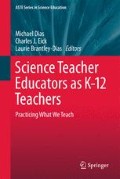Abstract
This chapter indicts the systems of formal schooling and of traditional educational research noting that such research over the last several decades has cost vast sums of money while yielding no discernable widespread improvements in the outcomes of formal education. While recognizing that schools and science education as now construed work for certain things, Don Duggan-Haas believes that they fail broadly if the goal is to nurture understandings of the social and natural world that inform decision making. After growing increasingly frustrated with traditional schooling and teacher education, Dr. Duggan-Haas left academia to join a start-up charter high school. By joining a team building a school from scratch, he intended to change his approach to educational improvement from making schools better to making better schools. The experience instead led him to change convictions further and, conceptually if not behaviorally, abandon the school paradigm altogether and begin a quest for making something better than schools.
Access this chapter
Tax calculation will be finalised at checkout
Purchases are for personal use only
Notes
- 1.
Some of the description of the epiphany was published on Slate.com in the author’s contest entry for imagining the classroom of the future.
- 2.
Note that I’m not claiming that the misery is universal, but it is most certainly widespread.
- 3.
See the impressive interactive graphic from the New York Times here: http://www.nytimes.com/2007/01/03/science/20070103_AGING_GRAPHIC.html.
- 4.
- 5.
References
Afferback, P., Pearson, P. D., & Paris, S. G. (2008). Clarifying differences between reading skills and reading strategies. The Reading Teacher, 61(5), 364–373.
Arkes, H. R., & Ayton, P. (1999). The sunk cost and concorde effects: Are humans less rational than lower animals? Psychological Bulletin, 125(5), 591.
Arkes, H. R., & Blumer, C. (1985). The psychology of sunk cost. Organizational Behavior and Human Decision Processes, 35(1), 124–140.
Bransford, J. D., Brown, B. L., & Cocking, R. (Eds.); Committee on Developments in the Science of Learning, National Research Council (U.S.). (2000). How people learn: Brain, mind, experience, and school (Expanded Ed.). Washington, DC: National Academy Press. Retrieved June 26, 2012, from http://books.nap.edu/catalog.php?record_id=6160
Campbell, J. (2008). The hero with a thousand faces (Vol. 17). New World Library. Retrieved June 26, 2012, from http://books.google.com/books?hl=en&lr=&id=I1uFuXlvFgMC&oi=fnd&pg=PP1&dq=The+Hero+with+a+thousand+faces&ots=oEflazTHKk&sig=E0tcz3GeGUCcwO-qFqBK7OnyrMM
Cutler, D. M., & Lleras-Muney, A. (2006). Education and health: Evaluating theories and evidence (Working Paper No. 12352). National Bureau of Economic Research. Retrieved June 26, 2012, from http://www.nber.org/papers/w12352
Donovan, M. S., & Bransford, J. D. (Eds.). (2005). How students learn: History, mathematics, and science in the classroom. National Academy Press, Committee on How People Learn, A Targeted Report for Teachers, Center for Studies on Behavior and Development, National Research Council.
Donovan, M. S., Bransford, J. D., & Pellegrino, J. W. (1999). How people learn: Bridging research and practice. Washington, DC: National Academy Press.
Duggan-Haas, D. (2000). Scientists are from Mars, educators Are from Venus: Relationships in the ecology of science teacher preparation. Doctoral dissertation, Michigan State University.
Eames, C., & Eames, R. (1977). Powers of ten. Documentary, IBM. Retrieved June 26, 2012, from http://powersof10.com/
Felton, T. (2011). Expeditionary learning core practices: A vision for improving schools. Expeditionary Learning. Retrieved June 26, 2012, from elschools.org/sites/default/files/Core%20Practice%20Final_EL_120811_9.pdf
Garet, M., Porter, A., Desimone, L., Birman, B., & Yoon, K. (2001). What makes professional development effective: Results from a national sample of teachers. American Educational Research Journal, 38(4), 915–945.
Kaser, J. S., Bourexis, P. S., Loucks-Horsley, S., & Raizen, S. A. (1999). Enhancing program quality in science and mathematics. Thousand Oaks: Corwin Press.
Meier, D. (1995). The power of their ideas: Lessons for America from a small school in Harlem. Boston: Beacon.
Moe, T., & Chubb, J. E. (2009). Liberating learning: technology, politics, and the future of American education (1st ed.). San Francisco: Jossey-Bass.
NSTA Board of Directors. (2006, May). NSTA position statement professional development in science education. Retrieved June 26, 2012, from http://www.nsta.org/about/positions/profdev.aspx
Tyack, D., & Cuban, L. (1995). Tinkering toward Utopia: A century of public school reform. Cambridge: Harvard University Press.
Tyack, D., & Tobin, W. (1994). The “grammar” of schooling: Why has it been so hard to change? American Educational Research Journal, 31(3), 453–479.
Wiggins, G., & McTighe, J. (1998). Understanding by design. Alexandria: ASCD.
Wiggins, G. P., & McTighe, J. (2005). Understanding by design (Expanded 2nd.). Alexandria: Association for Supervision and Curriculum Development.
Author information
Authors and Affiliations
Corresponding author
Editor information
Editors and Affiliations
Rights and permissions
Copyright information
© 2014 Springer Science+Business Media B.V.
About this chapter
Cite this chapter
Duggan-Haas, D. (2014). The Nail in the Coffin: How Returning to the Classroom Killed My Belief in Schooling (But Not in Public Education). In: Dias, M., Eick, C., Brantley-Dias, L. (eds) Science Teacher Educators as K-12 Teachers. ASTE Series in Science Education, vol 1. Springer, Dordrecht. https://doi.org/10.1007/978-94-007-6763-8_5
Download citation
DOI: https://doi.org/10.1007/978-94-007-6763-8_5
Published:
Publisher Name: Springer, Dordrecht
Print ISBN: 978-94-007-6762-1
Online ISBN: 978-94-007-6763-8
eBook Packages: Humanities, Social Sciences and LawEducation (R0)

